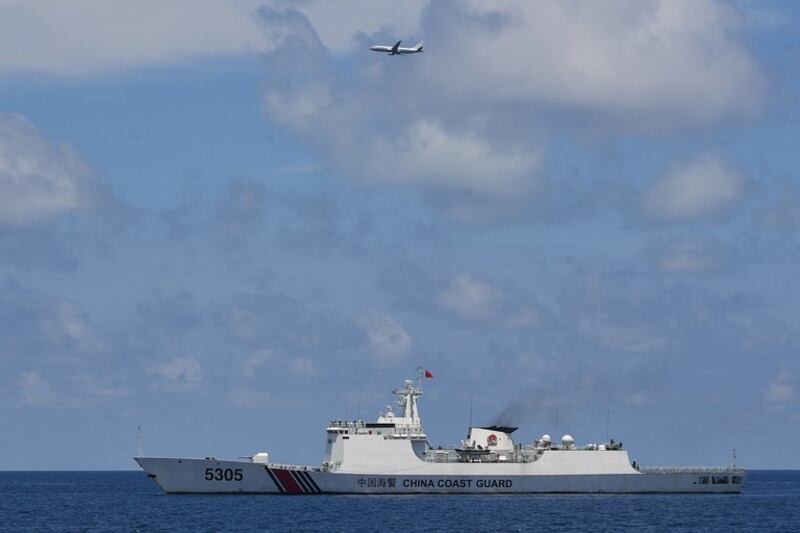The Philippines on Friday defended its joint South China Sea patrols with the United States against a Chinese claim that they were “provocative,” saying the maneuvers took place within its territorial waters and were consistent with international law.
But Manila remains open to “diplomatic discussions” with China, Filipino National Security Adviser Eduardo Año said, a day after the Philippine and U.S. militaries completed a second joint patrol in the disputed waterway.
“We wish to clarify that the joint maritime activities between the Philippines and the United States were clearly conducted within our exclusive economic zone (EEZ) and are consistent with international law, particularly the United Nations Convention on the Law of the Sea (UNCLOS), so how can they be deemed provocative?” Año said in a statement.
“The Philippines is merely exercising its sovereign right to engage in such activities within its territory.”
On Thursday, Chinese foreign ministry spokesman Wang Wenbin had called the Philippine-U.S. patrols “irresponsible,” saying they were “detrimental to management and control of the maritime situation and related disputes.”
Other nations must respect “efforts of countries in the region to maintain peace and stability in the South China Sea,” he said.
The Philippine national security adviser said Manila was committed to maintaining regional peace.
"Our joint patrols with the United States and potential future activities with other allied countries shows our mutual commitment to a rules-based international order and for promoting peace and stability of the region," Año said in a statement.
The national security adviser said Manila wanted to maintain a cordial rapport with all countries.
“The Philippines remains open to diplomatic discussions with China and reaffirms its commitment to fostering good relations with all nations,” Año said. “We believe that through peaceful dialogue and adherence to international law, we can achieve a resolution that serves the best interests of all parties involved in the region.”

In 2016, the Philippines won a landmark ruling in the Permanent Court of Arbitration in The Hague that threw out China’s expansive claims in the South China Sea. Beijing, however, has ignored the ruling and carried on with its military expansionism in the strategic waterway, including building artificial islands.
As was the case with the first round of joint patrols, which were launched in late November, this week’s patrols took place in the waters and skies of the Philippines’ EEZ.
The first joint sea and air patrols between the two allies, a three-day program, was meant to demonstrate bilateral muscle-flexing in the face of perceived Chinese aggression in the South China Sea and Taiwan Strait.
Those maneuvers involved three navy ships and three fighter-jets from the Philippine military, and one littoral combat ship and an aircraft from the American side.
The governments of both nations have been allies since they signed their Mutual Defense Treaty in 1951.
Message that ‘Philippines is not alone’
On Friday, Filipino military spokesman Col. Xerxes Trinidad said the second patrol, a series of operations held Wednesday and Thursday, required “complete coordination between Philippine and U.S. assets to enhance the operational capabilities and interoperability of both forces.”
For the activity, the Philippine military sent four ships, a multi-role helicopter, and an anti-submarine helicopter, while the U.S. Indo-Pacific Command, deployed an aircraft carrier, the USS Carl Vinson, and its strike group that included a cruiser, and two destroyers.
Maritime security expert Ray Powell, a retired U.S. Air Force officer, said the joint activity increased “Manila’s leverage” internationally.
“These exercises send the message that the Philippines is not alone in the West Philippine Sea, but must be considered by potential adversaries as part of a network of military allies and partners,” Powell told BenarNews on Friday.
Two weeks earlier, the Philippines said it intended to expand multinational patrols in the South China Sea. He said France, Canada, India, the U.K. and New Zealand had expressed an interest in joining such patrols.
All these nations support the 2016 arbitration court’s ruling that invalidated China’s sweeping claims to the sea.
In recent months, China has been harassing Filipino forces delivering supplies to its forces at its military outpost in Second Thomas (Ayungin) Shoal. Last month, a civilian-led convoy carrying Christmas gifts to forces there was forced to turn back after a Chinese ship shadowed it relentlessly.
Jeoffrey Maitem in Davao City, southern Philippines, contributed to this report.
BenarNews is an online news outlet affiliated with Radio Free Asia.
